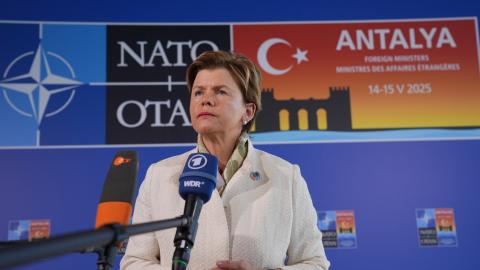Executive Summary
- US aids Ukraine’s long-range strikes: The United States has reportedly begun to provide Ukraine with intelligence support to aid Kyiv’s campaign against Russian energy infrastructure.
- More F-16s to Ukraine: Belgium is set to transfer F-16 combat aircraft to the Ukrainian Air Force as Brussels prepares to receive US-made F-35s.
- Battlefield assessment: The Russian military continued to focus troops and assets on the fight for Pokrovsk. Russia gained a significant amount of territory in September.
1. Ukraine Targets Russia’s Energy Sector with US Intelligence Support
Ukraine’s missile and drone raids on energy infrastructure deep inside Russia have accelerated dramatically since August 2025, exacerbating the country’s widespread fuel shortages. Reports now indicate that Ukraine has begun to receive intelligence from the United States to support these long-range salvos, including operational planning assistance for drone systems. Despite Washington’s aid, Kyiv retains the final say in target selection.
Ukraine’s operational design targets the Kremlin’s chief source of revenue: its oil refineries and pumping systems. This approach differs starkly from Ukraine’s previous attacks on the Russian energy sector, which were smaller and predominantly targeted oil storage facilities.
More importantly, Ukraine now possesses a powerful and growing pool of strike assets. This includes the indigenous FP-1 drone, which has accounted for 60 percent of deep strikes on Russian territory, and the Flamingo missile. Ukraine has also made range-extending modifications to other long-range systems. Official images appear to show a Neptune missile with a conformal fuel tank—an extra tank fitted closely to the profile of a projectile that extends its endurance.
Reports estimate that Kyiv has knocked out 20 percent of Russia’s oil refining capacity, though only temporarily. The long-term success of Kyiv’s campaign will depend on its operational tempo, the ability of Ukraine’s defense industry to sustain its production rates, and the continuation of US intelligence support.
2. Battlefield Assessment
Reports from the battle space suggest that the Russian high command has been gearing up to deploy follow-on troops to the long-embattled Pokrovsk sector, a key flashpoint across Ukraine’s eastern defensive belt. Moscow believes that worsening weather conditions there provide an opportunity to disrupt Ukrainian drone surveillance. Accordingly, the Kremlin has moved troops from occupied Luhansk and Donetsk to Pokrovsk. Moscow is also pouring materiel into the heavily contested sector via railways and roads.
Field observations and open-source visual intelligence have revealed tactical maneuvers and omnidirectional attack waves around Pokrovsk at a small-unit scale. Russian units have fielded motorcycle infantry alongside heavy armor in these attacks. Motorbike infantry groups now play meaningful roles in many Russian combat formations, including elite units such as the Russian Naval Infantry.
The Russian high command has also been reinforcing Novopavlivka with troops from elsewhere in theater. Additional engagements ramped up in Lyman, Kupiansk, Toretsk, and Siversk, where the Russian military maintained an offensive footing. In September 2025 Russia gained over 140 square miles of Ukrainian territory.
Russia continued to bombard Ukraine from the air, using North Korean KN-23 ballistic missiles, Kinzhal aeroballistic missiles, Iran-designed Shahed drones, and air-launched cruise missiles. The Ukrainian Air Force spotted Russian launch positions in occupied Crimea and Russia’s Rostov Oblast, and open-source imagery revealed that Russian forces have built a new launch facility in Bryansk. These launch positions’ proximity to the Ukrainian border makes them more vulnerable to counterstrikes. But this proximity also shortens the projectiles’ flight times, amplifying the blitz-like effect of Russian air raids.
In a positive development for Kyiv, Belgium will begin delivering F-16 aircraft to Ukraine in the coming days. The Belgian Air Force is set to receive US-made F-35s, which will replace the 30 F-16 airframes it is transferring to Kyiv. F-16s currently fly 80 percent of Ukraine’s combat sorties.
















